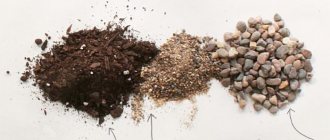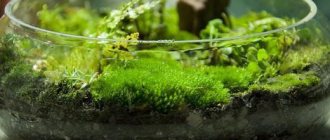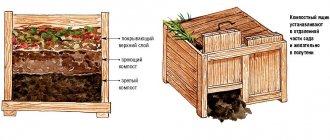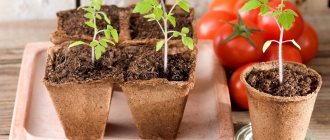Selecting quality seedlings
You can purchase ready-made seedlings on the market or grow them yourself. In any case, for planting it is necessary to select only those seedlings that have a well-formed root system and a strong stem reaching a height of 20 cm.
It is important that 8-9 full leaves are formed on each shoot. If they have a rich and uniform green color, this is a sure sign of a healthy seedling. Spotting or paleness of greenery indicates that the conditions for growing seedlings have been violated or that they are affected by some kind of disease.
If seedlings are grown independently, it is necessary to observe the correct temperature conditions for each stage of development and sowing dates.
Preparing the soil for tomatoes
Tomatoes are light-loving plants, but do not tolerate direct sunlight. The ideal place for them is a garden bed shaded by a nearby greenhouse or fruit tree. It is advisable that there are no drafts in this area.
It is recommended to plant seedlings in the place where cucumbers, onions or carrots grew last year. If potatoes were previously planted on the site, there is a risk of infection with various types of diseases such as late blight. It is very important to properly prepare the soil in advance.
Before planting, you need to enrich the soil with fertilizers and normalize the acidity. If this is not done, even with timely fertilizing, the tomatoes will wither and become sick. In specialized stores you can purchase a special test that will help you determine the pH of the soil yourself. For tomatoes, the ideal range is 6 to 7.
To reduce the acidity of the soil, it is recommended to use lime - per 1 sq. m, take 500 g. To increase acidity, sulfur is taken in the same proportions.
It is not recommended to plant tomatoes for two years in a row in the same area, but not everyone has the opportunity to change the location. In this case, soil reclamation can be carried out in the fall:
- In the fall, the soil is dug up and all plant debris is removed.
- Fertilizers are applied to the depth of the shovel bayonet - superphosphate, potassium salt or compost, humus, peat, bird droppings.
- Rye or white mustard is sown in the beds; it can be replaced with other green manures.
- To activate beneficial microflora, it is recommended to spill a humic solution on the soil.
It is not recommended to bury immature compost in the soil, as this can attract worms and wireworm larvae, which can harm the roots of young seedlings.
You should not add manure to the soil, because tomatoes love it very much, and as a result, all the energy will be used to increase only the green mass. The tops of the plant will begin to curl into a ring, but the harvest will be small. If there have been frosts, it is recommended to cover the soil with any black material around mid-May.
It is necessary to form beds for seedlings about a week before the intended planting. The depth of the holes should be at least 20 cm. It is recommended to water the soil with a solution of copper sulfate for several weeks. A solution is prepared in the following proportions: take 1 tbsp per 10 liters of water. l. This simple procedure will help disinfect the soil.
Mineral composition of the soil
For stable growth and development, the plant needs phosphorus, potassium and nitrogen. Fertilizers based on these elements are the key to a good harvest. The plant reacts to a lack of such nutrition by appearance:
- with a lack of nitrogen, the leaves are pale green, thin, small;
- phosphorus deficiency is manifested by red-violet leaves, plant growth and fruit formation slows down;
- with a lack of potassium, a bronze-colored border appears on the leaves;
- with insufficient calcium content (oxidation), the growing point and the top of the plant die.
To improve the mineral composition of the soil, use a bacterial cocktail. The solution contains a certain set of bacteria. They process nitrogen contained in the soil.
Tatyana Orlova (candidate of agricultural sciences):
Bacteria do not process nitrogen, but process plant residues contained in the soil, decomposing them to their elementary components - nitrogen, phosphorus, potassium. There are also nitrogen-fixing bacteria that can absorb nitrogen in the air and accumulate it in the soil.
You can buy it at any gardening store. The contents of 1 ampoule are used to treat 600 m2 of land.
Planting seedlings in open ground
For planting in open ground, only well-hardened seedlings can be used, otherwise most of the seedlings will be lost. A sharp change in weather conditions leads to a delay in the growth of seedlings. Depending on the climate of the region, the timing of planting young plants is adjusted. It is important to remember that tomato seedlings cannot tolerate too low temperatures at night or frost.
The optimal time for planting seedlings in open ground is May. If the temperature drops, it is worth using agrofabric or special structures with film to protect young plants.
Once the area with soil has been completely prepared for planting (the soil has been dug up and leveled), you can proceed directly to planting seedlings. It is best to do this early in the morning before the sun gets hot. Holes are dug for seedlings, with a small distance between them, depending on the selected plant variety.
If the tomato bushes are tall, the best option would be a distance of about 60 cm, for a small crop – about 40 cm. If tomatoes are planted in several rows, it is recommended to place the plants in a checkerboard pattern, which will make it possible to save space. A distance is left between the rows, which also depends on the variety - from 40 to 70 cm.
After not very deep holes are formed, it is necessary to disinfect the soil. For this purpose, potassium permanganate is dissolved in water; the resulting composition should have a light pink tint. The holes are watered generously with the solution, after which you can additionally water the soil with clean water. It is important that the soil is well moistened before planting. After planting, it is not recommended to water the seedlings for several days.
Planting tomatoes in open ground: step-by-step instructions
The process of planting tomato seedlings in open ground is very simple, just follow the following recommendations:
- Planting is carried out only after frosts have passed and above-zero temperatures will last for a week. This could be early May or June.
- The area should be sunny and well ventilated, but without drafts. An excellent choice would be the south-eastern, south-western or southern part of the site.
- After the first flower cluster appears on the seedlings, it can be planted in open ground. The seedlings should have at least 6 fully formed leaves.
- It is recommended to plant tomato seedlings at the age of 50-60 days, but this figure may vary depending on the type of plant chosen.
- Pre-prepared holes are watered - no more than a liter of water per hole.
- You need to wait until the water is completely absorbed into the soil.
- If at the time of planting the seedlings have stretched too much, several lower leaves are cut off.
- After the pruning procedure, the seedlings are transplanted into deep soil; the adventitious roots located on the lower part of the stem provide the tomatoes with additional nutrition. Strongly elongated seedlings are placed obliquely and must be buried to half the stem.
- Standard seedlings are placed in a hole in a vertical position and buried down to the cotyledon leaves.
- The holes are watered again, and a small layer of dry earth is poured on top.
It is not recommended to plant seedlings where there are plants that can harm them, for example, fennel, zucchini or potatoes. The growth of tomatoes is positively influenced by proximity to onions, basil, bird cherry and celery.
What soil to plant in: necessary substances and chemical elements in the composition
Soil is the main source of nutrients consumed during plant growth. The soil for tomato seedlings must be rich in microelements and vitamins. Otherwise, the seedlings will get sick and die. The correct soil composition must include :
- nitrogen;
- phosphorus;
- magnesium;
- potassium.
Thanks to these chemical elements, tomatoes grow strong and healthy.
In the standard composition, any component can be replaced with a similar one or other substances can be added. The main composition of the soil may contain the following components :
Sphagnum moss. Helps improve breathability.
- Meadow and turf soil.
- Conifer needles. They protect young seedlings from pests and aphids, and also help increase productivity.
- Peat. Improves looseness and moisture capacity. Due to the high acidity of peat, it is recommended to dilute it with dolomite flour or chalk. The large fibers contained in peat contribute to tangling of the root system. It is for this reason that it is recommended to pre-sieve the peat.
- Leaf soil. Gives lightness to the soil and makes it loose, but contains a small amount of nutrients. Therefore, you will have to independently add the missing components to the composition of the leaf soil. Tomatoes react very negatively to tannins, so collecting leaf soil under oak or willow for seedlings is not recommended.
- Sand is a natural leavening agent. A prerequisite is that the sand used for growing seedlings must be clean, washed, and without pieces of clay. Before adding to the soil, the sand must be rinsed well with running water and calcined in the oven.
- Perlite is used as a leavening agent and moisture retaining agent.
- Humus. In order not to ruin young tomato shoots, you need to use only well-rotted humus. Before applying the component requires mandatory sifting.
- Sawdust can easily replace peat or sand included in the soil. When preparing soil mixture for seedlings, it is recommended to use clean sawdust, previously scalded with boiling water.
Seedling care
Proper and timely care of seedlings helps to achieve good fruiting. To develop a strong root system and provide the plant with the necessary amount of oxygen, it is recommended to loosen the bed every 2-3 weeks - the tool is immersed in the soil to a depth of at least 8-10 cm. If the soil is dense enough, this procedure should be carried out more often.
Loosening is often combined with weeding, because weeds can provoke a real pest invasion. Grass retains moisture in the soil, which creates excellent conditions for the development of various diseases. A heavily thickened bed is poorly ventilated.
Watering and fertilizing
Watering should be carried out directly under the root of the plant; do not water the greens. If you choose from existing irrigation systems, it is best to opt for spot irrigation. The use of sprinkling can lead to shedding of inflorescences, causing blanching of the fruits.
After planting, do not water the seedlings too often. It will be enough to perform water procedures several times a week. It is necessary to ensure that the soil does not dry out.
When watering tomatoes, consider the following tips:
- Excessive watering is harmful.
- For watering, use water at room temperature.
- When watering, try not to get it on the trunk and leaves of plants, otherwise it may cause burns.
- Tomatoes need to be watered in the evening, with the exception of hot sunny days.
- Before hilling, during the flowering of the first and second clusters, it is necessary to water the plant.
It is recommended to fertilize tomatoes 4-5 times throughout the entire growing season. Fertilizing is applied according to the following scheme:
- The first time fertilizing is done 15 days after transplanting seedlings into open ground. For this, nutritious infusions of bird droppings or mullein can be used, to which a little wood ash is added. At this time, the bushes begin to gain buds, so applying fertilizer will have a positive effect on the process of formation of fruit ovaries.
- The second feeding is carried out 10 days after the second brush blooms on the bushes. An organic infusion is used with the addition of complex mineral fertilizer in the following proportions - take 1 tbsp per bucket. l. If the tomatoes are tall, add 1.5-2 liters of infusion, for low-growing ones - no more than 1 liter.
- The third feeding should be carried out during the ripening of the first tomatoes. The same nutritional composition is used, but in this case its volume changes - 500 ml of solution is poured under each bush.
- The last feeding is performed 15 days after the third. The ideal option would be to use industrial fertilizer Agricola-3, into which superphosphate is introduced - for every square meter. m 4 liters of solution.
Read more information about feeding tomato seedlings here.
Stepsoning
The formation of side shoots or stepsons must be carried out as the tomato bushes grow. They simply do not have time to ripen, simultaneously drawing out large amounts of nutrients. Therefore, they need to be removed at the early stages of bush development.
2-3 main shoots are left on each plant. By the time the fruits begin to ripen, there should be no stepsons on the bushes. The side shoots, 3-5 cm long, are removed. They need to be broken off or pinched off at a distance of about 1 cm from the main stem. During the procedure, work carefully to avoid leaving large wounds on the plant. It is advisable to perform pinching in the morning.
What soil mixture is better to buy in the store?
To choose soil for tomato seedlings you need:
- Decide which primer is best suited for use, universal or special. For beginning gardeners, a soil mixture marked “universal” is suitable .
- Check the package with soil for a label with instructions for use, chemical and mechanical composition and information about the manufacturer. If this information is not available, then it is better not to purchase such a soil mixture.
- Good soil should consist of 3-4 elements : two types of peat, vermiculite or sand, mineral fertilizer. The amount of chemicals such as phosphorus, nitrogen, potassium should not exceed 300-400 mg/l.
- The soil purchased should be loose, without large lumps and not greasy. Water should drain well through such soil.
Benefits of Store Soil:
- The soil is almost ready for use.
- You can purchase the necessary packaging (from 1 to 50 liters).
- The composition is rich in all necessary elements.
Flaws:
- The amount of microelements is not always indicated correctly.
- Acidity is indicated approximately.
- Instead of peat, the manufacturer can add peat dust, which is not suitable for growing seedlings.
- You may get contaminated soil or with insect larvae.
Next, you can watch a video on how to analyze finished soil:
Tying tomatoes
Tall varieties require additional tying. This prevents the plants from falling to the ground and makes harvesting easier. The tying procedure itself is very simple:
- A peg is installed next to each plant that will be tied.
- You can dig strong stakes along the edges of the row, and then stretch a cord or twine between them.
- Twine, as well as thick synthetic threads, are considered excellent materials for garters. The main advantage is that they do not rot.
- You can use metal or wooden stakes.
- You don't need to tie the plants too tightly to a stake or wire.
- To strengthen the stems, a mesh, lattice or cap made of twigs can be used.
Pollination
Tomatoes are self-pollinating plants that easily cope with this issue. Insects – bumblebees and bees – provide great assistance in the pollination process. To attract them to the site, you can plant such fragrant honey plants as mint, rapeseed, lemon balm, coriander, mustard, and basil.
In some cases, artificial pollination is required:
- Each bush is shaken a little.
- You can simply tap the blooming brush, but not too hard.
- This procedure is carried out in the first half of the day.
- After pollination is completed, you need to spray or water the tomatoes with warm water so that it flows over the flowers.
Soil requirements
The main requirement is that the soil must contain all the elements necessary for the development of seedlings.
The soil should be:
- Loose.
- It is good to allow moisture and air to pass through.
- Have sufficient, but not excessive amounts of nutrients.
- Have neutral or weak acidity.
- It should not contain toxic substances, harmful microorganisms, weed seeds, fungal spores, eggs or larvae of insect pests.
Diseases and pests of tomatoes, control methods
There are quite a few pests that can harm tomatoes, the most common of which are:
- The mole cricket is an insect that settles on well-fertilized and moist soils. To combat it, strong insecticidal preparations are used, including infusions of vinegar and red pepper.
- Wireworms are larvae that are covered with a dense shell and damage the root system of the plant. For prevention, during autumn site preparation, acidic soils are alkalized.
- Gnawing cutworms - these caterpillars are considered the most dangerous enemy of vegetable crops. For prevention, it is recommended to carry out deep mechanical tillage and timely weeding. If caterpillars appear in large numbers on tomatoes, they must be collected and destroyed manually.
Mole cricket - a pest of tomatoes
Wireworms: these larvae cause damage to the root system
Gnawing cutworms are dangerous caterpillars
Tomatoes can suffer from the Colorado potato beetle, thrips, spider mites, whiteflies and melon aphids. To combat these types of pests, it is worth using insecticidal preparations.
It is recommended to carry out preventive spraying of tomatoes every 5-7 days, alternately using onion infusion and Bordeaux mixture. If the plant has been affected by a dangerous infection, serious treatment is required.
Tomatoes are often subject to diseases such as blossom end rot, mosaic, late blight, wild spot, anthracnose, fomoz, etc. In this case, it is necessary to treat the plants with special potent fungicides, and the affected parts of the plant must be removed.
If the tomatoes are severely damaged, complete destruction of the planting is required. To minimize the likelihood of re-development of the infection, before the new season the soil must be treated with disinfectants, for example, watered with a solution of copper sulfate, a hot solution of potassium permanganate, and deep digging is performed.
How to deoxidize the soil
What kind of soil do lilies like?
So, what soil acidity should be for tomatoes is known - no more than 6.5. If the pH value exceeds the norm, the tomatoes will become sick. You can determine the acidity of the soil yourself, just look at the weeds that grow on it. Creeping wheatgrass, an almost indestructible pest, grows in areas with low pH levels. But woodlice feels good in very acidic soil, so thickets of this grass clearly indicate that the soil for tomatoes needs to be deacidified.
It’s easy to check acidity at home. To do this, you need to brew currant leaves with boiling water and let the broth brew. Then add a little soil from the site to the jar and watch the reaction. If there is a lot of acid, the water will turn red, blue indicates low pH, and green indicates neutral soil.
What to use to deoxidize the soil:
- Lime . In the fall, sprinkle a bucket of fluff lime per 1 m2 of land, and then loosen the soil. It is not recommended to mulch for the winter; in the spring such soil will take a long time to thaw. If the alkalinity is too high, sulfate granules are added to the soil.
- Dolomite flour . ¾ bucket of flour is used per 1 m2, and then the soil is loosened for winter.
- Ash . For the first time, take a three-liter jar of ash per 1 m2 of soil; next year the amount of fertilizer can be reduced.
- Phacelia . Beautiful lilac flowers grow quickly, reduce the acidity of the soil and prevent the appearance of wireworms. The plot is sown with phacelia throughout the summer; next year tomatoes can be grown in this soil.
Dolomite flour (packaging)
In terms of pH level, peat is suitable for tomato seedlings; it has low and sometimes neutral acidity. The main disadvantage of such soil is the absence of a large amount of nutrients; peat soil will need to be enriched with turf, sand and organic matter.
Important! Peat is often used as an inert component in the soil, but it is worth remembering that its high variety is more acidic. Such peat must be deoxidized before planting tomatoes.
The main mistakes when growing tomatoes
To protect the crop from major losses, it is worth familiarizing yourself with the mistakes that inexperienced gardeners often make:
- Violation of the timing of planting seeds or seedlings.
- Using tomato varieties that are intended for growing in a greenhouse.
- Purchasing seedlings with inflorescences, as the formation of ovaries is disrupted.
- Too much and frequent watering leads to rotting of the root system.
- Excessive fertilization.
- Planting seedlings ahead of schedule in open ground - violation of the temperature regime negatively affects the formation of ovaries.
Choosing a location in the garden plot
It is advisable to carry out crop rotation of vegetable crops and alternate them when placing them. Without such a procedure, the soil for tomato seedlings will accumulate a large number of diseases. Tomatoes take root well in places where onions, carrots, zucchini or cabbage previously grew. Planting seeds should not be carried out in the area where there were potatoes or eggplants, and tomatoes can take root in the old place only after 3 years.
After harvesting the crop that grew in front of the tomatoes, the soil is peeled and semi-steamed. Next, the plowed land is plowed and harrowed in two tracks in the spring.
Tomatoes will not grow well under the following conditions:
- excess organic fertilizers in the soil layer;
- crowding and distance less than 45 cm between bushes;
- excessively wet or dry soil for tomatoes in the greenhouse and in the open area;
- too shaded place for planting.
Harvesting
In mid-summer the harvest period begins. Since uneven ripening occurs, the fruits must be collected every day. Tomatoes need to be harvested without stems. You should not wait until the fruits are completely ripe, because in room conditions they reach ripeness perfectly.
To speed up the ripening process, you can place the tomatoes in a well-lit and ventilated place. To delay ripening, it is recommended to place the fruits in a cool and dark place.
Let's watch a video about how to grow tomatoes in open ground. What kind of feeding should be done, and how to understand what elements the plant lacks, how to plant tomatoes, and how to significantly increase the future harvest:
Caring for and growing tomatoes is not as complicated a process as it might seem at first. It is enough to adhere to the above tips and do not forget about regular weeding, fertilizing and watering.
0
0
Copy link











